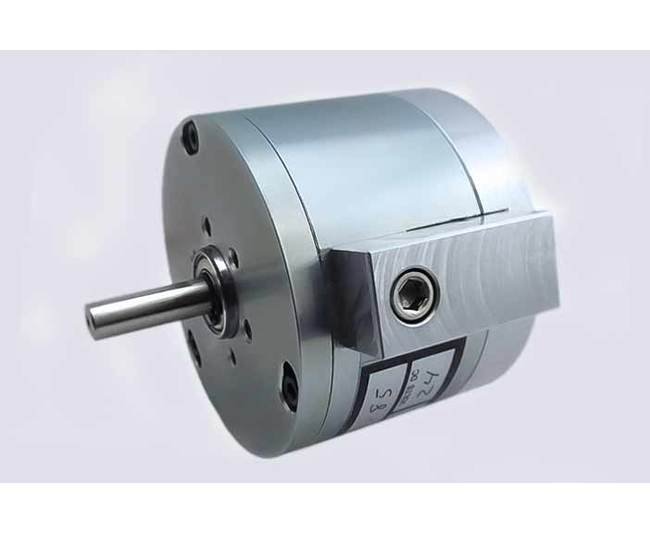Placid Industries Hysteresis Particle Brake - 6W, 0.6-35 oz·in Torque
Placid Industries Hysteresis Particle Brake - 6W, 0.6-35 oz·in Torque
SKU:HYS-f23419
Smooth, reliable torque control from 0.6 to 35 oz·in with Placid Industries' Hysteresis Particle Brake.
Regular price
$349.99
Regular price
Sale price
$349.99
Unit price
per
Delivery via Maden
Expect your order to arrive on time.
Secure Payments
All orders are processed through a secure, PCI-compliant checkout.


The Placid Industries Hysteresis Particle Brake offers a torque range of 0.6 to 35 oz·in, suitable for producing tension in a variety of applications like unwinding wire, fiber optic cable, and narrow webs. With an input electric power of 6W, this brake delivers smooth and consistent torque output, independent of RPM, making it ideal for light tension scenarios. Designed with Placid Industries' Cog-Buster to ensure slip torque remains smooth, this brake guarantees reliable performance even at high RPM. The absence of friction plates or magnetic particles ensures a long operational life and magnetic torque transmission across an air gap.
Product Specifications
Characteristics Characteristics
Torque is produced without friction plates or magnetic particles. Life is extremely long, even at high RPM, because torque is produced magnetically across an air gap.Slip torque is extremely smooth, even down to zero RPM. Placid Industries' Cog-Buster automatically de-cogs the brake within one revolution of the shaft.With no electrical excitation, the shaft freely rotates.With electrical excitation, the shaft becomes coupled to the case.While the load torque is less than the output torque, the shaft wonât rotate continuously.When the load torque is increased, the brake will slip smoothly at the torque level set by the coil input current.Not suitable for precise positioning applications
Determining Proper Brake Size Determining Proper Brake Size
Determining Proper Brake SizeThe proper sized brake mustâ¦Have sufficient torqueBe able to dissipate the heatNo run above rated speedTorqueFor load simulation, torque limiting and similar applications, torque is already known.For web handling, torque must be calculated. First determine the desired tension in your web (wire, fabric, film etc.).Calculate Torque: Torque (lb-inches) = Tension (lbs) x Roll Diameter (inches) x 0.5Use the Full Roll Diameter for calculating the maximum torque needed. For applications with the web running over a pulley or between nip rollers (pinch rollers), use the pulley diameter as the roll diameter in the formula above. Always be conservative - select the next larger model if the application requires nearly the rated torqueRPM (must be less than the maximum allowable)For load simulation, torque limiting and similar applications, RPM is already known.For web handling, usually linear speed (Web Speed) is known, and RPM must be calculated.Calculate RPM: RPM = 3.8 x WEB SPEED (feet per minute)/ROLL DIAMETER (inches)Use the Full Roll Diameter to determine the slowest speed. Use the Core Diameter (empty spool diameter), to determine the fastest speed. For applications with the web running over a pulley or between nip rollers (pinch rollers), use the pulley diameter as the roll diameter.Slip Heat Dissipation (model must be physically large enough not to overheat)For any application.Calculate Heat Input: HEAT (watts) = TORQUE (lb-inches) x RPM x 0.012For unwinding applications.Calculate Heat Input: HEAT (watts) = WEB TENSION (lbs) x WEB SPEED (feet/minute)/44Duty CycleThe average heat input must be below the brake's heat dissipation rating. If the motion is intermittent, use the average speed for thermal (SLIP) calculations.
Note Note
Mounting holes - Standard: Imperial (inch), Optional: Metric
Specifications Available Direct Current Dc Coil Voltage
6 V | 12 V | 24 V
Specifications Configuration
Shaft on either side or shaft on two sides
Specifications Input Electric Power
6 W
Specifications Maximum Overhung
5 lb | 21 N
Specifications Maximum Speed
8,000 rpm
Specifications Shaft Inertia 106
92 x 10-6 lb·in·sec²
Specifications Slip Heat Dissipation Cover Off
25 W
Specifications Slip Heat Dissipation Cover On
15 W
Specifications Torque Range
0.6 to 35 oz·in | 0.43 to 24.7 lb·in | 0.43 to 24.7 N·cm
Specifications Applications
Producing tension for unwinding wire, fiber optic cable, and narrow webs.Load simulation for testing electric motors.Applications requiring light tension/wide RPM capability.
Specifications Weight
2 lb | 0.90 kg
Torque Torque
Is proportional to input current.Is independent of RPM.Imperial Unit â Torque Range: 0.04 -2.5 to 7-250 (oz-in)Metric Unit â Torque Range: 0.03-1.77 to 4.3-177 (Newton-cm)


